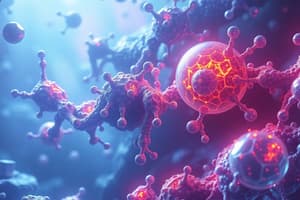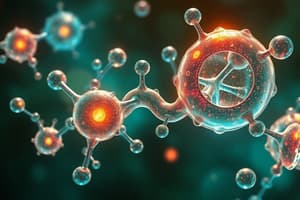Podcast
Questions and Answers
Enzymes are proteins that act as biological ______.
Enzymes are proteins that act as biological ______.
catalysts
The reactant in the biochemical reaction is termed the ______.
The reactant in the biochemical reaction is termed the ______.
substrate
The molecule the enzyme produces is known as the ______.
The molecule the enzyme produces is known as the ______.
product
The site on the enzyme where the reaction occurs is called the ______ site.
The site on the enzyme where the reaction occurs is called the ______ site.
One class of enzymes, known as ______, catalyze oxidation-reduction reactions.
One class of enzymes, known as ______, catalyze oxidation-reduction reactions.
Pyruvate is converted into ______ through various chemical processes.
Pyruvate is converted into ______ through various chemical processes.
The enzyme class known as ______ catalyzes the formation of bonds between carbon and other atoms.
The enzyme class known as ______ catalyzes the formation of bonds between carbon and other atoms.
1 isomerases or ______ isomers can be racemized by specific enzymes.
1 isomerases or ______ isomers can be racemized by specific enzymes.
CH3-Cc is an example of an ______ compound involved in metabolic reactions.
CH3-Cc is an example of an ______ compound involved in metabolic reactions.
The process of decarboxylation involves removing ______ from pyruvate.
The process of decarboxylation involves removing ______ from pyruvate.
Lactate is converted to ______.
Lactate is converted to ______.
The reaction involves the transfer of ______, N-, or P-.
The reaction involves the transfer of ______, N-, or P-.
The enzyme catalyzes the cleavage of bonds by the action of ______.
The enzyme catalyzes the cleavage of bonds by the action of ______.
Serine can be converted into ______.
Serine can be converted into ______.
Urea is produced from the cleavage of ______.
Urea is produced from the cleavage of ______.
Enzymes such as ______ catalyze various biochemical reactions.
Enzymes such as ______ catalyze various biochemical reactions.
The process also involves coenzymes like ______.
The process also involves coenzymes like ______.
Vmax is directly proportional to enzyme ______.
Vmax is directly proportional to enzyme ______.
An increase in temperature can lead to enzyme ______.
An increase in temperature can lead to enzyme ______.
The reaction can generate energy in the form of ______.
The reaction can generate energy in the form of ______.
Enzymatic reactions can be affected by changes in ______.
Enzymatic reactions can be affected by changes in ______.
In Michaelis-Menten kinetics, S binds reversibly to E to form the ______ complex.
In Michaelis-Menten kinetics, S binds reversibly to E to form the ______ complex.
The reaction velocity increases as the ______ of the enzyme concentration rises.
The reaction velocity increases as the ______ of the enzyme concentration rises.
Enzymes that follow Michaelis-Menten kinetics typically display a ______ shape.
Enzymes that follow Michaelis-Menten kinetics typically display a ______ shape.
Allosteric enzymes show a ______ curve.
Allosteric enzymes show a ______ curve.
The maximum velocity is reached at a fixed concentration of ______.
The maximum velocity is reached at a fixed concentration of ______.
______ is the term used for the substance that enzymes act upon.
______ is the term used for the substance that enzymes act upon.
Increasing substrate concentration affects the ______ rate of a reaction.
Increasing substrate concentration affects the ______ rate of a reaction.
If the substrate concentration is low, the reaction rate will be ______.
If the substrate concentration is low, the reaction rate will be ______.
As more substrate is added, the reaction velocity approaches ______.
As more substrate is added, the reaction velocity approaches ______.
The relationship between substrate concentration and reaction velocity in enzymes is often described by the ______ equation.
The relationship between substrate concentration and reaction velocity in enzymes is often described by the ______ equation.
Study Notes
Enzymes
- Biological catalysts; they increase the rate of reactions without themselves being changed
- Selective and specific; the reactant in the biochemical reaction is termed substrate. The molecule the enzyme produces is known as the product
- The site on the enzyme where the reaction occurs is called the active site
Enzyme Classes
- Oxidoreductases: Catalyze oxidation-reduction reactions with examples such as lactate to pyruvate
- Transferases: Catalyze transfer of functional groups such as C-, N-, or P-containing groups
- Hydrolases: Catalyze cleavage of bonds by addition of water
- Lyases: Catalyze cleavage of C-C, C-S, and certain other bonds
- Isomerases: Catalyze racemization of geometric isomers
- Ligases: Catalyze formation of bonds between carbon and O, S, N coupled to hydrolysis
Factors Affecting Reaction Velocity
- Substrate Concentration
- Allosteric enzymes show sigmoidal curves, whereas enzymes following Michaelis-Menten kinetics show hyperbolic curves.
- Enzyme Concentration
- Vmax is directly proportional to enzyme concentration, meaning more enzymes result in a faster reaction
- Temperature
- The reaction velocity increases with temperature up to a certain point until it reaches a maximum, after which it decreases due to denaturation.
- pH
- Each enzyme operates optimally at a specific pH range; extreme pH values can denature the enzyme
Michaelis-Menten Kinetics
- An enzymatic reaction typically involves the reversible binding of the substrate to the enzyme to form an ES complex.
- The ES complex reacts irreversibly to generate a product and regenerate free enzyme.
Studying That Suits You
Use AI to generate personalized quizzes and flashcards to suit your learning preferences.
Related Documents
Description
This quiz covers the roles and classifications of enzymes as biological catalysts. You'll learn about different enzyme classes, their functions, and factors that affect reaction velocity. Test your understanding of how enzymes work and their importance in biochemical reactions.




